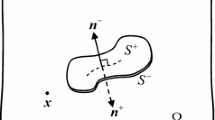Abstract
Selection of the electric boundary condition on crack faces in piezoelectric fracture mechanics has concerned researchers for a long time, and this may be related to discrepancies between the experimental measurements and theoretical predictions based on linear piezoelectric crack models that have been reported. In this letter, three well known electric boundary conditions, namely, impermeable, permeable and the boundary condition suggested by Parton en Kudryavtsev and Hao and Shen (PKHS condition) are discussed. We demonstrate that the impermeable condition is invalid for treating cracking problems, due to its physically unrealistic features and a mathematical singularity. Also, we show that the permeable condition can be used only in conjunction with nonzero mechanical traction boundary condition along the crack faces. Finally, it is shown that the PKHS condition is a reasonable one, but that the permittivity of the media inside the crack gap must be nonzero.
Similar content being viewed by others
References
Deeg W.F. (1980) The analysis of Disclocation, Crack, and Inclusion Problems in Piezoelectric solids. Ph. D. Theses, Stanford University, Stanford, California.
Dunn M.L. and Taya M. (1994) Electroelastic Field Concentrations in and around Inhomogeneities in Piezoelectric Solids. ASME Journal of Applied Mechanics 61, 474–475.
Hao T.-H. and Shen Z.-Y. (1994) A New Electric Boundary Condition of Electric Fracture Mechanics and Its Application. Engineering Fracture Mechanics 47, 793–802.
Heyer V., Schneider G. A., Balke H., Drescher J. and Bahr H. A. (1998) A Fracture Criterion for Conducting Cracks in Homogeneously Poled Piezoelectric PZT-PIC 151 Ceramics. Acta Materialia 46, 6615–6622.
Kumar S. and Singh R. N. (1997a) Energy Release rate and Crack Propagation in Piezoelectric Materilas, Part I, Mechanical/Eletrical Loads. Acta Materialia 45, 849–857.
Kumar S. and Singh R. N. (1997b) Energy Release rate and Crack Propagation in Piezoelectric Materials, Part II, Combined Mechanical and Electric Loads. Acta Materialia 45, 859–868.
Landau L.M. and Lifshitz E. M. (1960) Electrodynamics of Continuous Media. Plenum Press, New York.
McMeeking R. M. (1999) Crack Tip Energy Release Rate for a Piezoelectric Compact Tension Specimen. Engineering Fracture Mechanics 64, 217–244.
McMeeking R. M. (2001) Towards a Fracture Mechanics for Brittle Piezoelectric and Dielectric Materials. Internationa Journal of Fracture 108, 25–41.
Park S. B. and Sun C. T. (1995a) Fracture Criteria for Piezoelectric Ceramics. Journal of the American Ceramic Society 78, 1475–1480.
Park S. B. and Sun C. T. (1995b) Effect of Electric Fields on Fracture of Piezoelectric Ceramics. International Journal of Fracture 70, 203–216.
Parton V. Z. (1976) Fracture Mechanics of Piezoelectric Materials. Acta Astronautica 3, 671–683.
Parton V. Z. and Kudryavtsev B. A. (1988) Electromagnetoelasticity. Gordon and Breach Science Publisher, New York.
Ru C. Q. (1999) Electric-Frield Induced Crack Closure in Linear Piezoelectric Media. Acta Materialia 47, 4683–4693.
Sosa H. and Khutoryansky N. (1996) New Development Concerning Piezoelectric Materials with Defect. International Journal of Solids and Structures 33, 339–3414.
Suo Z., Kuo, C. M., Barnett D. M. and Willis J. R. (1992) Fracture Mechanics for Piezoelectric Ceramics. Journal of the Mechanics and Physics of Solids. 40, 739–765.
Tobin A. C. and Pak Y. E. (1993) Effect of Electric Fields on Fracture Behavior of PZT Ceramics. Proceedings of SPIE, Smart Structures and Materials. 1916, 78–86.
Xu X.-L. and Rajapakse R. K. N. D. (1999) Analytical Solution for an Arbitrary Oriented Void/Crack and Fracture of Piezoelectrics. Acta Materialia 47, 1735–1747.
Xu X.-L. and Rajapakse R. K. N. D. (2001) On a Plane Crack in Piezoelectric Solids. International Journal of Solids and Structures 38, 7643–7658.
Author information
Authors and Affiliations
Rights and permissions
About this article
Cite this article
Ou, Z., Chen, Y. Discussion of the Crack Face Electric Boundary Condition in Piezoelectric Fracture Mechanics. International Journal of Fracture 123, L151–L155 (2003). https://doi.org/10.1023/B:FRAC.0000005808.89187.97
Issue Date:
DOI: https://doi.org/10.1023/B:FRAC.0000005808.89187.97



